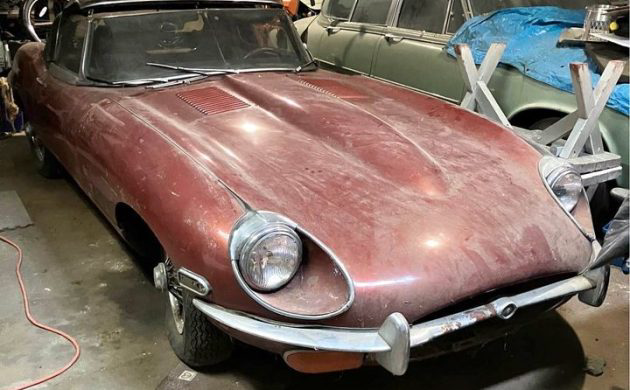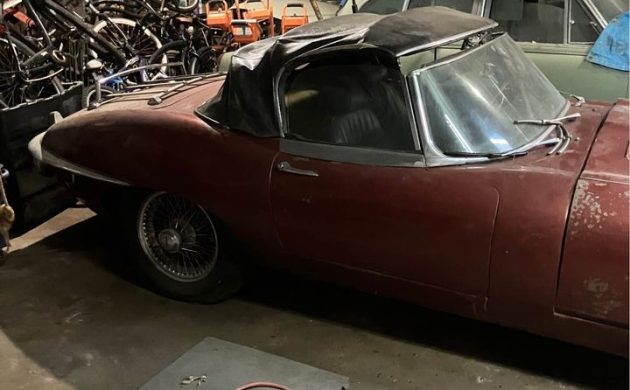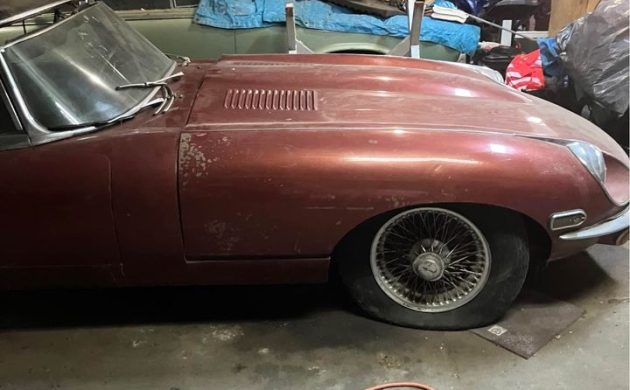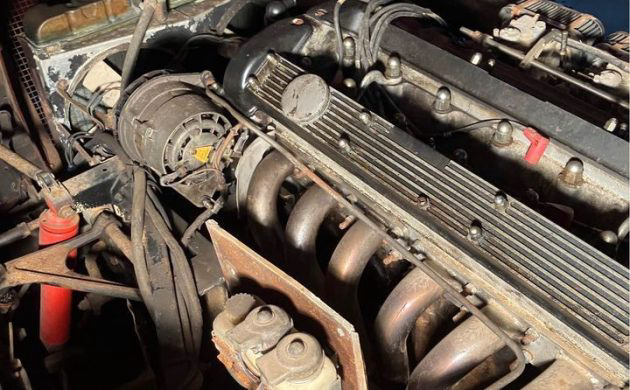Series II Garage Find: 1970 Jaguar XK-E Roadster
If I park an old car for a year, that seems like a long time to me. Leaving one unattended for 30 years? That seems like an eternity! How or why that happens, I don’t know but there are probably a myriad of reasons. You know, “It needs major repairs and I’ll get around to it.” Or, “I’m going to do a full restore (when I can afford it).” Or maybe it belonged to an important family member who has passed and the current caretaker can’t bear the thought of saying goodbye. I don’t know the particulars behind this 1970 Jaguar XK-E roadster, the listing is light on details, but let’s examine what’s here and see if it tells a story.
Rockaway Park, New York is where this Jag has experienced its thirty-year sojourn. Total XK-E production for ’70 amounted to a total count of 6,732 units, spread across three body styles including a roadster and a standard or 2+2 coupe. The XK-E or Type E as this Jag model is known, had a long model run, having been introduced in 1961 and seeing production continue through 1974. All told, better than 70,000 XK-Es rolled off its Coventry, England assembly line.
The problem with barn finds is that they’re usually covered with a thick coat of dust, and often debris too, so it’s hard to tell the true condition of the finish and body. In this case, what appears to be Signal Red paint shows signs of fade and peel, especially on the rear edge of the bonnet. I don’t see an indication of rust or rot but the included images aren’t that revealing. Of note is the front bumper, it’s slightly bent, the bane of many XK-Es, it seems. While the convertible top looks frumpy, the wire wheels reveal no rust.
The leather upholstery is in a rough, but not torn, shape. It could possibly be revived, but I imagine it will remain deeply creased. The steering wheel is a non-original piece and the upper center gauge binnacle has been pulled loose from its mooring – I wonder why? As for the rest of what’s visible, it looks to be as worn as the upholstery.
Jag power is courtesy of a 266 HP, 4.2-liter in-line six-cylinder engine mated to a four-speed manual gearbox. The powerplant looks complete and is claimed to be a numbers-matching component, but one has to wonder about its useability after sitting for such a long stretch. It would be nice to know if the motor will at least turnover.
The verdict? I don’t think there’s enough here to make any kind of accurate judgment. An XK-E is a sophisticated enough car that it warrants more images, extensive listing detail, and probably, a different medium to effect a proper sale. Please look this one over and let me know if you agree; you can find it here on Facebook Marketplace where this claimed 53K mile drop-top is available for $39,000.
Auctions Ending Soon
 2006 Ford Mustang Saleen S281 SCBid Now1 days$15,000
2006 Ford Mustang Saleen S281 SCBid Now1 days$15,000
 2002 Subaru Impreza WRXBid Now4 days$100
2002 Subaru Impreza WRXBid Now4 days$100
 1975 Chevrolet Corvette ConvertibleBid Now4 days$3,000
1975 Chevrolet Corvette ConvertibleBid Now4 days$3,000
 1964 Ford F-100 Camper CustomBid Now4 days$2,000
1964 Ford F-100 Camper CustomBid Now4 days$2,000
 2006 Jeep Wrangler SportBid Now6 days$5,650
2006 Jeep Wrangler SportBid Now6 days$5,650







Comments
I’m sure that this Jag’s colour as seen in the pics is NOT “Signal Red”, by any stretch of the imagination….I’ve seen many, many LBCs thru the years in that colour, so as to be able to discern it from all other reds. Plus, the Jags’ paint has an obvious metallic paint hue to it, which “Signal Red” never had.
OK, you’ve claimed what you don’t think it is, what is it then?
JO
Good question JO… but it certainly ain’t an official BMC / British Leyland colour for that model year, and that includes all of their Jag models produced that year. Your guess is as good as mine, though, for what colour it really is. Perhaps even the seller doesn’t know the exact colour of the respray??
My only other suggestion is Regency Red, it was available, supposedly, in ’70
JO
Definitely not Regency Red either. Both of the original red finishes were non-metallic. This is not an original Jag color. Maybe it could be found on the Earl Schibe or Miracle color pallet.
Regarding the center gauge panel, that is a hinged piece that allows access to the fuses.
Having owned a couple of these (a ’64 coupe and a ’70 roadster) I can truthfully say that, aside from it’s looks, the ’70 was superior in every way, and I wish I still had it. But I digress, that was in 1973., and in California. As with anything from New York, I would recommend a thorough inspection for rust. These cars are of a semi-monocoque design with the aft section providing the bulk of rigidity and because of that,not that simple to repair. Not much in this class of car that drives much better, even with the wire wheels!
Did a complete bare metal restoration on up on a ’69 coupe for a customer. Love these cars but after finishing that one l said it was the first and last one, and it was. Beautiful to look at and pure fun to drive, but the phrase “overcomplicated” applies to almost everything about these cars. If this car here isn’t covered with rust and the buyer has a healthy bank account, this car will make a great weekend driver.
I actually would be more interested in the green Jag sedan parked next to it!!
You know, there’s something extremely unsettling about seeing what Enzo Ferrari was supposedly to have said, “The XKE is the most beautiful car in the world” ( although there’s no proof he actually said that), a car we as kids dreamed about, better than the Corvette even, reduced to a dilapidated, forlorn condition, it’s kind of like that childhood actress you liked and seeing her now. Jags are and always have been for the deep of pocket, misers have no business in a Jag, so that puts me out. Oh, I had my chance, recalling my story of my ’71 MGB for $1995 in 1974. Right next to it on the lot, was a 1970 Jag like this, only puke green, for $2895!!! Try as I might, I couldn’t raise the extra $900 bucks, a lot of money for a 21 year old punk then. I think the loan officer didn’t want me driving a nicer car than him. I never regretted the MGB, but always wonder what if?
Triple webers and headers too.
I’m thinking dual Webers since the original came with dual Strombergs. Triples were in 67 only I believe and they were SUs (HD6s or 8s?). Big Healeys also had trip carbs for 1 year (62?) with smaller SUs that were replaced with dual larger SUs (HD8s). Assume the changes were for easier synchronisation of the carbs although the trips when properly adjusted were awesome.
Nor the 3 Weber carburators.
To me I’m reasonably certain something other than the standard 3/8 inch lift short duration camshafts are in place and who knows what other modifications to that engine. Higher compression forged pistons?
The tendency for the crankshaft to break on the 6th journal is very likely if more than the factory redline is used to shift at.
Actually it tends to break on the main journal between 5&6.
That proves To be of the few weaknesses of that fabulous 4.2 liter engine.
30 years ago puts that car away in the 90’s. And 20 Some years old when it occurred. looking at all the engine mods It’s reasonable to assume they occurred after at least 1 rebuild at a time when those cars really didn’t have much resale.
I used to buy non running ones for a few hundred dollars, less if any rust was visible.
I didn’t value the 4.2 as much as the 3.8 ( except for that wonderful transmission). The 3.8 had symmetric cylinders directly under the combustion chambers in the head.
The 4.2 in order to get the bigger bore in the same sized engine had to move the cylinders around generating side loads on the rods. 5500 was the absolute limit if you didn’t want that crank to flex and break. Oh, you might get away with the rare 6000 rpm but if you drove it hard above 6000 that poor crankshaft would simply quit on you.
The original color was undoubtedly black, because whenever they repaint these cars, they never paint the rails inside the engine compartment, and these are still black.
The price is a little cheeky at 39k. BaT just sold a really nice one recently for around 5k more than this. I’d predict a sale of this car only if the price is below 25k.
Back your 401K up to this Jag and unload it. You will thank us later.